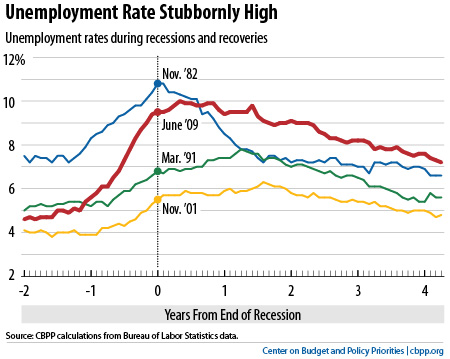September Jobs Report: Economic Recovery 'Disappointingly Slow'

The Bureau of Labor Statistics released its jobs report Tuesday indicating the economic recovery is continuing at a snail's pace. When compared with other contemporary recessions, including those from '01, '91, and '81, the Great Recession remains unparalleled. Likewise, recovery in each of the earlier recessions picked up considerably two years following peak unemployment.
Credit: Center on Budget and Policy Priorities
According to the BLS, 148,000 jobs were added in September while the unemployment rate remained relatively unchanged at 7.2 percent. Chad Stone, chief economist at the Center on Budget and Policy Priorities, called growth "disappointingly slow."
"Today’s jobs report shows that the labor market recovery remains disappointingly slow, with employment still well below normal levels and long-term unemployment still near historic highs... The temporary federal Emergency Unemployment Compensation (EUC) program, which President Obama and Congress authorized through the end of the year, provides additional weeks of unemployment insurance (UI) benefits to workers who exhaust their regular state UI benefits before they can find a job. In most states, that’s after 26 weeks and, as the chart shows, roughly four out of 10 jobless workers have now been out of work and looking for a job for 27 weeks or more."Credit: CPPP

Unemployment has yet to reach pre-2007 levels, and involuntary part-time workers have remained the same at 7.9 million.
From the BLS report:
Among persons who were neither working nor looking for work in September, 2.3 million were classified as marginally attached to the labor force, down by 215,000 from a year earlier. These individuals had not looked for work in the 4 weeks prior to the survey but wanted a job, were available for work, and had looked for a job within the last 12 months. The number of discouraged workers, a subset of the marginally attached who believed that no jobs were available for them, was 852,000 in September, essentially unchanged from a year earlier.Credit: CPPP



